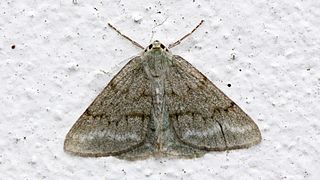
The geometer moths are moths belonging to the family Geometridae of the insect order Lepidoptera, the moths and butterflies. Their scientific name derives from the Ancient Greek geo γεω, and metron μέτρον "measure" in reference to the way their larvae, or inchworms, appear to measure the earth as they move along in a looping fashion. A very large family, it has around 23,000 species of moths described, and over 1400 species from six subfamilies indigenous to North America alone. A well-known member is the peppered moth, Biston betularia, which has been subject of numerous studies in population genetics. Several other geometer moths are notorious pests.

Pingasa is a genus of moths in the family Geometridae first described by Frederic Moore in 1887.

Pingasa rubicunda is a species of moth of the family Geometridae first described by William Warren in 1894. It is found in northern India, Sundaland and the Philippines.

Pingasa ruginaria is a species of moth of the family Geometridae first described by Achille Guenée in 1857. It is found in India, south-east Asia, the Ryukyu Islands and Sundaland.

The Pseudoterpnini are a tribe of geometer moths in the subfamily Geometrinae. The tribe was described by Warren in 1893. It was alternatively treated as subtribe Pseudoterpniti by Jeremy Daniel Holloway in 1996.

Cleora repetita is a species of moth of the family Geometridae first described by Arthur Gardiner Butler in 1882. It is found from Sundaland to Australia and the Solomon Islands.

Pingasa hypoleucaria is a species of moth of the family Geometridae first described by Achille Guenée in 1862. It is found on Réunion and Mauritius.

Pingasa angulifera is a moth of the family Geometridae first described by William Warren in 1896. It is found in Queensland, Australia.
Pingasa blanda is a moth of the family Geometridae first described by Arnold Pagenstecher in 1900. It is found on New Guinea, on the Bismarck Archipelago and in Queensland, Australia.
Pingasa cinerea, the tan-spotted grey, is a moth of the family Geometridae. The species was first described by William Warren in 1894. It is found in the Australian states of New South Wales, Queensland, Tasmania and Victoria.
Pingasa decristata is a moth of the family Geometridae first described by William Warren in 1902. It occurs on São Tomé Island.
Pingasa grandidieri is a moth of the family Geometridae first described by Arthur Gardiner Butler in 1879. It is found on Madagascar.
Pingasa lahayei is a moth of the family Geometridae first described by Charles Oberthür in 1887. It is found in Spain, North Africa and tropical Africa, including the Gambia.
Pingasa multispurcata is a moth of the family Geometridae first described by Louis Beethoven Prout in 1913. It is found in Yemen, Arabia, Iraq, from Iran to Pakistan and in north-western India.
Pingasa javensis is a moth of the family Geometridae first described by William Warren in 1894. It is found on Java.
Pingasa meeki is a moth of the family Geometridae first described by William Warren in 1907. It is found on New Guinea.
Pingasa nobilis is a moth of the family Geometridae first described by Louis Beethoven Prout in 1913. It is found in New Guinea and Queensland, Australia.

Pingasa subpurpurea is a moth of the family Geometridae first described by William Warren in 1897. It is found on Borneo, the Philippines and Sulawesi.
Pingasa subviridis is a moth of the family Geometridae first described by William Warren in 1896. It is found in India on Peninsular Malaysia, Sumatra, Java and Borneo. The habitat consists of forested lowland areas up to 1,930 meters.
Pingasa venusta is a moth of the family Geometridae first described by William Warren in 1894. It is found in the north-eastern Himalayas, Sundaland and on Sulawesi, Seram and on New Guinea. The habitat consists of lowland areas up to 1,930 meters, including disturbed vegetation and secondary forests.










